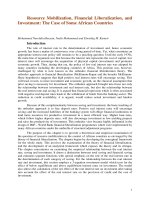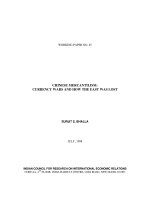Tài liệu Chinese mercantilism - Currency wars and How The east was lost pptx
Bạn đang xem bản rút gọn của tài liệu. Xem và tải ngay bản đầy đủ của tài liệu tại đây (267.02 KB, 40 trang )
WORKING PAPER NO. 45
CHINESE MERCANTILISM:
CURRENCY WARS AND HOW THE EAST WAS LOST
SURJIT S. BHALLA
JULY, 1998
INDIAN COUNCIL FOR RESEARCH ON INTERNATIONAL ECONOMIC RELATIONS
CORE-6A, 4
TH
FLOOR, INDIA HABITAT CENTRE, LODI ROAD, NEW DLEHI-110 003
2
Foreword
The Asian financial crisis has generated a lot of research, analysis and debate.
The exact causes of the crisis are not firmly established, although various
hypotheses have been offered. This paper presents one view of the genesis of
the East Asian crisis. Several explanations are examined: managed exchange
rates, over and undervalued currencies, crony capitalism, asset bubbles,
Japanese devaluation, or “too much” capital account liberalization.
A large part of the analysis centers around the proposition that the regime of
managed exchange rates was at the core of the problem. In addition, the paper
offers an additional contributory cause of the crisis - China’s mercantilist policy.
The role of the international system in allowing China to devalue its currency (by
over 50 percent), despite burgeoning trade surpluses, is also addressed. The
paper also explores the question of whether the Chinese economy needed any
devaluation in the early nineties.
I have no doubt that this paper will provoke debate and contribute to a better
understanding of an issue which is occupying the minds of most policy makers
around the world.
Isher Judge Ahluwalia
Director & Chief Executive
ICRIER, New Delhi
3
Table Of Contents
Foreword.........................................................................................................................2
Table Of Contents...........................................................................................................3
CHINESE MERCANTILISM :.......................................................................................4
CURRENCY WARS AND HOW THE EAST WAS LOST............................................4
1. INTRODUCTION.................................................................................................4
2. CHINA, DEVALUATION, AND MERCANTILISM - SEEDS OF A CRISIS......6
a. The Data............................................................................................................7
b. The Evidence.....................................................................................................8
c. Genesis of the Crisis - Did China need to devalue the yuan in 1991-93 ?............8
d. The Importance of Chinese Devaluation ............................................................9
(i) China vs. Greater China data......................................................................10
(ii) Export and Import data...............................................................................11
(iii) The counter-factual...................................................................................12
e. Summarizing the Macro Evidence....................................................................13
f. The Micro Evidence.........................................................................................13
g. Did Devaluation Hurt Chinese Imports (and Asian Exports) ?..........................14
h. Political Economy of Trade Surpluses .............................................................14
i. Mercantilism defined........................................................................................14
j. Mercantilism Index says YES...........................................................................15
k. Why Can’t All Countries be Mercantilist ? ......................................................15
3. ALTERNATIVE EXPLANATIONS OF THE CAUSES.....................................15
a. Did Japan Devaluation Cause the Crisis ? ........................................................15
b. Did Capital Account Liberalization cause the problem ?..................................16
c. Is Capital Account Liberalization not good for LDCs ?....................................17
d. Crony Capitalism and Non-Performing Assets of Banks..................................18
e. Equity and Property Markets............................................................................19
f. The perverse role of fiscal surpluses.................................................................19
4. WHAT DID HAPPEN ?......................................................................................20
a. Capital flows and fixed exchange rates.............................................................20
b. Zero hedging costs...........................................................................................20
c. Floating exchange rates would have avoided the crisis.....................................21
d. Efficient Excess Capacity Creation..................................................................21
e. How to Compete? ............................................................................................21
f. Response of East Asia......................................................................................21
g. Plaza is the parallel..........................................................................................21
5. CONCLUSIONS.................................................................................................22
References ....................................................................................................................37
4
CHINESE MERCANTILISM :
CURRENCY WARS AND HOW THE EAST WAS LOST
Surjit S. Bhalla
1
1. INTRODUCTION
The world changed on July 2, 1997 when Thailand floated the baht.
Explanations abound on the origins of the crisis - indeed it is a growth industry.
This study is part of that explosion. It has several objectives. Identification of the
causes of the crisis is the most important goal. Why did it happen ? Why did the
contagion happen ? What went wrong ? Was the East Asian miracle a mirage ? If
causes are correctly identified, the correct policy response is expected to follow.
If not, then developing countries may embark on another lost decade.
A large part of the analysis centers around the proposition that the regime of
fixed, quasi-fixed, managed exchange rates was at the core of the problem. In
addition to managed exchange rates, the paper offers an additional contributory
cause of the crisis - China’s mercantilist policy. The role of the international
system in allowing China to devalue its currency (by over 50 percent in the early
nineties), despite burgeoning trade surpluses, is also addressed. This two cause
hypothesis is an ex-post one, and one that does not exclude other contributory
factors. Over-investment (actually an outcome of the above two factors) played a
part, as did property price booms.
The analysis suggests a presence of “currency” wars. It is probable that the East
Asian policymakers at least partially welcomed the Thai crisis because it allowed
them to get out of the straitjacket of fixed exchange rates - and, like US with
Japan a decade earlier (Plaza agreement), allowed them to be competitive once
again. A twenty something devaluation was common in the previous three
decades and the policymakers probably felt that the devaluation could be
beneficial, and handled without a crisis. Indeed, Taiwan stated as much when
they said that for “competitive” reasons it was going to let the currency
depreciate from its managed level of 28 NT/dollar (and it allowed the Taiwanese
dollar to depreciate by about 25 percent). However, markets are difficult to
control, much more so in today’s capital flow world. The situation got out of hand
and a “welcome” devaluation turned into a crisis. The fact that a crisis did occur
does not negate the logic that a priori, the devaluation was desired (and
planned?) by countries of East Asia.
1
President, Oxus Research and Investments, New Delhi. This paper has greatly
benefitted from useful comments made at a seminar held at ICRIER, New Delhi on
31.7.98 and is a revised version of the draft presented at that Seminar.
5
The role of China’s devaluations (the 1990-93 devaluation was the last salvo -
the yuan had already depreciated by close to 200 percent in nominal terms, and
close to 100 percent in real terms by the time of the “last” 90-93 devaluation) in
“messing” up the East Asian fixed exchange rate “agreement” should not be
underestimated. If most countries have their currencies fixed, and overvalued,
there is a consumer loss all around, but there is little possibility of a crisis - or a
currency war. Several implications for exchange rate policies in developing
countries follow from the analysis of the crisis. First, countries are unlikely to
create the climate for a future currency war. Therefore, less fixed or more
floating exchange rates will be the norm; the latest conversion of Brazil to this
new reality is a confirmation of this trend. This also implies that the movement
towards capital account convertibility in developing countries is inexorable and
inevitable. Most Asian and Latin American and Eastern European nations have
their currencies significantly more convertible today than in June 1997, the date
prior to the onset of the crisis.
Second, that China, having helped to create the “crisis”, is unlikely to devalue
anytime soon. This is based on an additional reason - according to calculations
presented in Developing Trends (1998) the Chinese yuan is today under-valued
with respect to the dollar by about 10 to 15 percent. This forecast of a “no
devaluation” of the Chinese yuan incorporates political realities. (The Hong Kong
peg is a different issue and the Chinese may under the guise of exchange rate
unification (again!) devalue the Hong Kong dollar to the $-yuan rate of 8.3 from
the 7.75 HKD/US at present). International politics (particularly US) may be an
important force in determining exchange rate policies in developing countries.
And it is precisely an extension of this politics which leads to the conclusion that
China will not devalue as a quid-pro-quo to the US for allowing it to pursue a
mercantilist policy in the nineties.
Other implications also follow from this forecast. Without a Chinese devaluation,
the East Asian economies will be able to recover faster, and the world can move
towards a more level playing field. Capital account convertibility will likely
accelerate, and bring with it reduced real interest rates, and higher growth in
developing countries. And all without the imposition of old-new schemes to
control capital flows (Tobin tax) and without new global institutions to supplant or
replace the IMF.
The paper is organized as follows. Section 2 looks in detail at the argument that
the Chinese devaluation was not important in causing Crisis ’97. The arguments,
and data, are examined in detail; the conclusion - Chinese devaluation was
critical in reducing the competitiveness of the East Asian economies. Section 2
also documents the mercantilist policies of China. Section 3 looks at other, more
common, explanations of the crisis. Section 4 outlines the development of the
crisis and Section 5 concludes.
6
2. CHINA, DEVALUATION, AND MERCANTILISM - SEEDS OF A CRISIS
Most commentators agree that managed exchange rates were a major cause of
Crisis ’97, though the desire by some for a re-imposition of capital controls
suggests that the economic house is still divided. Operation of a managed
exchange rate, is, after all, a form of capital control. A legitimate question arises -
if controls were a major part of the problem, how can they now be a significant
part of the solution?
The earliest commentators (Bergsten (1997), Bhalla(1997), Makin(1977), and the
Economist (1997)) suggested that China’s devaluation of its currency by 50
percent on Jan. 1 1994, was a major contributory cause of the East Asian
devaluations. This view seems to be accepted by most market participants,
though not necessarily by most economists. The market takes it for granted that
an additional Chinese devaluation would deliver a knock-out blow to world
stabilization efforts, and lead to a new currency war. Hence, the market implicitly
believes that the 90-93 Chinese devaluation caused the 1997 East Asian crisis.
The IMF was among the first to question the China devaluation thesis, and it did
so in a footnote in the World Economic Outlook of Dec. 1997.
“It has been argued by some observers that the devaluation of the Chinese yuan
at the beginning of 1994 also had a significant adverse effect on the
competitiveness of Southeast Asian economies. In terms of the U.S. dollar, the
unification of the yuan implied a devaluation of the official rate by 50 percent,
which is comparable to the yen’s depreciation between mid-1995 and mid-1997.
However, since by late 1993 a large part (estimated at 80 percent) of foreign
exchange transactions were already essentially carried out at the swap market
rate, the effective depreciation is estimated to have been less than 10
percent….The yuan’s devaluation therefore had a much smaller impact on these
countries international competitiveness than the depreciation of the yen during
1995-1997. In fact, structural reforms in China may have been a more important
source of improvements in its international cost competitiveness in recent years;
these may be inadequately reflected in real exchange rate data and may have
affected the trade performance of China’s Asian competitors significantly” .
(footnote 4, page 7, IMF(1997), italics added).
While rejecting the China devaluation hypothesis, the IMF offered the hypothesis
that the devaluation of the yen, from mid-1995 onwards, may have been
responsible for the East Asian crisis. The Economist also echoed the view that
the China devaluation was not relevant.
7
“A misunderstanding of recent history may have caused those worries to be
overdone.. Some commentators (including The Economist) have contended that
China’s last devaluation, in 1994, hurt its neighbours’ exports, which inexorably
led to this years traumatic devaluations. This analysis, however, ignores the fact
that China’s devaluation, an impressive 50 % on paper, amounted to less in fact.
Prior to 1994 China operated two exchange rates; while the official rate was
sharply devalued, the rate at which four-fifths of China’s foreign trade was
conducted barely changed at all. So South-East Asia’s 1996 slump cannot be
blamed on China’s 1994 devaluation.” (p.83, Dec. 13, 1997, emphasis added).
The World Bank, in its “official” response to the crisis (World Bank, 1998), did not
mention the Chinese devaluation as a possible cause; nor did it contend that the
East Asian currencies were overvalued in 1997.
A detailed analysis of the hypothesis that China’s devaluation was unimportant
was offered by three economists at the International Division of the Federal
Reserve Board of the US. In a study entitled “Was China the First Domino ?
Assessing Links between China and the Rest of Emerging Asia”, (March 1998)
authors Fernald, Edison and Loungani (hereafter referred to as FEL) contend
that “the devaluation was not economically important: the more relevant
exchange rate was a floating rate that was not devalued, and high Chinese
inflation has led to a very sharp real appreciation of the currency”. FEL present
evidence on export shares of China and its competitors from 1993-1997 to
support their conclusion. Incidentally, while rejecting the Chinese devaluation
thesis, the authors do not provide an explanation for why the East Asian crisis
occurred.
a. The Data
The debate on the effects of Chinese devaluation has helped to highlight the
large discrepancies in the trade data. Exports and imports data as revealed by
(own) national accounts data of individual countries (and reported in IMF
International Financial Statistics, (IFS)) differ, sometimes radically, from the data
reported by recipient countries, and reported in a sister publication of the IMF,
Direction of Trade Statistics or (DOTS). Using discrepancies in own and
recipient country data, Bhalla(1995) warned, as early as April 1995, of the
undervaluation of the Chinese yuan and the effects of such undervaluation on
Chinese competitiveness and Chinese trade surpluses.
There are very large differences in trade data as reported by China the exporter
and as reported by recipient countries with recipient country data showing
exports to be about 60 per cent higher. Imports are also higher but by a much
lower percentage (see Table 1). The Chinese data suggests a large deterioration
in the trade account from 1990 to 1993 - the trade account moves from a surplus
of $ 9 billion to a deficit of $ 11.9 bn. Using recipient country data, the trend is
opposite - a large trade surplus in 1990, $40 billion, turns even larger in 1993 - $
8
49 billion. Incidentally, China is one of the few countries (detailed investigation is
in progress) to have such large differences between own and recipient country
accounts. Even FEL, whose thesis is that the devaluation was not important,
argue in favor of using recipient country data. Our thesis, that the devaluation
was important, also prefers recipient country data.
b. The Evidence
Background data on the Chinese economy in the nineties is reported in Table 1.
Three exchange rates are reported - the official exchange rate, the theoretical
parallel exchange rate for exporters, and a weighted exchange rate reflecting the
actual rate faced by exporters. The differences in the latter two rates reflects the
operation of the dual exchange rate system whereby exporters were allowed to
keep approximately 70-80 percent of export proceeds.
This table substantiates the proposition that the devaluation on Jan. 1 1994 was
not actually equal to the nominal 50 percent devaluation (from 5.8 yuan to 8.7
yuan) but rather a smaller 7 percent (8.1 to 8.7). (Note that the table reports end-
period data while the devaluation took place on Jan 1 1994 when the official
exchange rate changed from 5.8 to 8.7 yuan). However, this valid point is
fundamentally trivial and pertains to the specification of the exact date of the
devaluation. In addition, there are major problems with this (trivial but correct)
technical objection. The Chinese devaluation was not a one-off affair but rather a
continuous process over the preceding few years, a point noted by FEL as well
(also see Mehran et. al. (1996)). If the occasion of devaluation is shifted from
Jan. 1, 1994 to just six months earlier i.e. June 1993, then the effective exporter
devaluation was 16 % and if shifted to mid-1992, the devaluation for exporters
was a high 35 percent. Since the discussion is about the loss in competitiveness
of Asian economies post 1993, the exact timing of “when” prior to Jan. 1, 1994 is
of relatively little consequence. In any case, most analysts agree that export
markets react with a lag to exchange rate changes.
While the (ex) free falling Indonesian rupiah made these thirty something
devaluations insignificant, it should be emphasized that historically, such
devaluation magnitudes are high. India devalued by only 20 percent in 1991,
and that was considered far reaching. Further, as shown in Table 2, this Chinese
devaluation was in the context of either stable or appreciating exchange rates in
South - East Asia.
c. Genesis of the Crisis - Did China need to devalue the yuan in 1991-93 ?
Before discussing the consequences of the Chinese devaluation, an earlier
question needs to be addressed: did the Chinese economy require the stimulus
of a devaluation in 1990 to 1993 ? According to figures reported in Table 1, the
answer seems to be an overwhelming NO. The preceding five years (1985 to
1989) the Chinese economy grew at an average growth rate of 9.5 % per annum
9
with inflation at a high 14 percent; inflation then collapsed to a 4 % rate 1991-
1993, and economic growth remained high at 9 percent. Trade surpluses were
most likely reflecting a large under-valuation of the yuan; such surpluses had
exactly doubled from $ 40 billion per year 1985-89 to an average of $ 80 billion
during 1990-1993. With such robust statistics, most economists would not have
advocated an expansionary devaluation policy. However, China continued to
devalue from 1990 to end-1993 and the World Bank had this to say in its glowing
China 2020 report published in mid-1997: “Perhaps most important, the
government maintained a realistic exchange rate policy. It almost halved the
exchange rate at the outset of reforms and devalued the currency on four later
occasions” (World Bank, 1997a, p. 10, emphasis added).
d. The Importance of Chinese Devaluation
Economists make two arguments against the hypothesis that the Chinese
devaluation played a contributory role. First, it is pointed out that China did not
devalue, the exchange rate was only unified, not devalued. Second, that the 50
percent devaluation that did occur from 1990 to 1993 did not hurt East Asia
because all these countries increased their export share in the “nineties”. Both
these objections to the “China devaluation is important” thesis are examined in
detail below.
There is a curious aspect to the view that the Chinese mega-devaluation (from
1990-1993) was irrelevant. Most economists recommend devaluation for
redressing trade deficits - it helps increase exports and decrease imports. (As
shown below, not only did China not have trade deficits, it had huge trade
surpluses prior to the devaluation.) It is reasonable to expect, therefore, that an
increase in China’s “trend” exports, and a decrease in its “trend” imports, would
cut into the export share of its competitors. Hence, if the textbook consequences
of a devaluation were to occur, then it is likely that China’s competitors were hurt.
The debate about the importance of Chinese devaluation centers on data, and its
interpretation. There are aspects where there is general agreement i.e. recipient
country trade data should be used rather than national data – this because of
vast differences in the two, especially for China. There are centers of conceptual
agreement as well – the competitors are correctly identified as the East Asian
neighbours, and trade performance (rather than GDP growth, or inflation, or
interest rates etc.) is the correct barometer. But even on agreement, there can be
differences. For example, should the competitors be the Asean4 countries
(Indonesia, Malaysia, Philippines and Thailand) or should they be the Asean7
countries (above four plus Korea, Singapore and Taiwan)? On trade, should only
export data be examined, or both exports and imports? If the latter, then trade
imbalances (surpluses and deficits) become an important criterion.
There are areas of disagreement as well (between economists and between the
analysis contained here and in FEL). Should China be considered as the
10
comparator (this paper), or should it be Greater China i.e. China plus Hong Kong
(as preferred by FEL)?
Yet another important consideration for analysis is the time-period chosen.
China’s devaluation for exports was a continuous affair between 1990 and 1993.
When the exchange rate unification occurred on Jan. 1, 1994, importers were
confronted with a 50 percent devaluation. So for exports, the proper time-period
of analysis is 1990 to 1997, and for imports 1993 to 1997. The end-point is
dictated by the onset of the crisis in July 1997; in the data presented in this
paper, the 1997 data are for end-June 1997 i.e. the data has been annualized for
1997 according to data for the first two quarters.
Given the large set of combinations of data possible, Charts 1-3 and Tables 1-8
contain data on all the combinations reported above. This over-presentation of
data is necessary because of the importance of the question, and the differences
in the results. Fernald-Edison-Loungani (and the IMF) conclude that the Chinese
devaluation was unimportant – using the same data, we reach a completely
opposite conclusion – the Chinese devaluation was a critical cause of the East
Asian crisis.
The reader can make up her own mind as to what set of assumptions are
necessary to examine the economic implications of the China devaluation. A
readers guide to the three major differences between the Fernald-Edison-
Loungani and our analysis of China’s and East Asia’s trade performance is as
follows.
(i) China vs. Greater China data
FEL prefer to use data for Greater China while we advocate a preference for only
mainland China. China devalued its currency by a huge 50 percent between
1990 (the start of the exchange rate unification program) and 1993. The Hong
Kong currency stayed stable. If effects of devaluation on trade performance is the
subject of investigation, then it is inappropriate to combine the trade data for
China and Hong Kong.
In support of their controversial decision, FEL offer the following argument: “it
makes economic sense to combine China and Hong Kong trade data (even
before the handover) because it is conceptually difficult to differentiate between
the contributions of Chinese and Hong Kong firms” (p. 7). FEL cite Krugman
(1997) to support their (questionable) reasoning: “Krugman also argues that we
should combine China and Hong Kong, on the grounds that conceptually, it is like
separating the trade statistics for New York city and the rest of the United
States”.
The FEL-Krugman argument is less than convincing. Even for data after the
handover (June 1997) it is not clear that the trade statistics for China and Hong
11
Kong should be combined. The two regions have different exchange rate
regimes, hugely different devaluations (large versus none), different costs,
different tax structures, and different comparative advantages. The data for the
two regions tell a different story. At the margin, it is the case that taking the
extreme step of combining Hong Kong and China data helps the FEL argument
because Hong Kong exports grew at a considerably lower rate than Chinese
exports. But it could be that the growth rates differ by the extent they do because
China had a large devaluation and Hong Kong did not. If one is trying to prove
that Chinese devaluation did not have an effect, then it maybe erroneous to base
the analysis only on export data for Greater China, rather than just mainland
China.
China’s exports to industrialized countries (IC’s) grew at a 17 percent annual
rate in the nineties, more than double the rate of the ASEAN7 economies (Table
3). Since world exports to IC’s grew at 4.9 percent , it is apparent that the export
share increased for both China and the Asean countries. China, however, shows
a considerably larger increase (Table 4a). While the ASEAN7 increase their
share by barely 1 percent over 7 years - from 6.9 to 7.9 percent - China’s share
more than doubles from 1.7 to 3.7 percent. Greater China’s share also increases
by more than sixty percent - from 2.7 percent to 4.4 percent. Korea and Taiwan
register a decline in market share. Little evidence, therefore, that the “new” and
“cheap” exporter did not hurt East Asian exports.
(ii) Export and Import data
Another major difference between FEL and us is in the use of overalll trade data,
rather than exclusively export data. Concentration on the latter makes one ignore
the reality that devaluation is a double-edged sword - it hurts the competitors in
third markets, and via imports in one’s own market.
FEL primarily concentrate on the use of export shares to demonstrate that the
China devaluation was unimportant. Both the IMF and FEL are completely silent
on the effects of the Chinese devaluation on Chinese imports, and China’s trade
surplus. For imports the official devaluation of 50 percent was equal to the actual
devaluation, with predictable effects. Proper beggar-thy-neighbor policies entail
an increase in trade surplus which comes about not only through large gains in
exports, but also via smaller growth in imports. Import substitution can be
achieved both with import taxes or with an under-valued exchange rate. This
seems to have happened in China - as shown in Tables 1 and 5, import growth
collapsed, and trade surpluses zoomed in the post 1993 devaluation period. As
shown in Table 6, China averaged a trade surplus of $ 54 billion per year with the
industrialized countries during 1990 to 1997; Greater China averaged $ 40 billion;
Asean4 only $ 13 billion and the Asean7 countries – an average deficit of $4.2
billion per year!
12
(iii) The counter-factual
Even if the extreme assumption of only export shares is accepted, there is still
the problem of the problematic counter-factual. Even if the restrictive FEL criteria
are accepted - export shares of the Asean4 countries, with respect to Greater
China, in only the post 1993 period (Tables 3 to 7), one cannot conclude that the
devaluation was unimportant.
Export shares of the competitor Asean4 countries increased (with respect to the
rest of the world, but not with respect to China) from 1993 to 1997, so how can
one argue that China devaluation hurt? This line of reasoning is reminiscent of
the arguments made in the early nineties defending the state intervention
practiced in high growth economies of East Asia (see Wade, Petri) i.e. these
countries grew at high rates, so state intervention must have had positive effects.
The response to that argument was that what mattered was not the absolute
level of growth, but rather the potential rate of growth. Phrased differently, what
mattered was the rate of growth of total factor productivity(TFP).
Parenthetically, the World Bank’s World Development Report (WDR) of 1991
was the first to document the low TFP growth achieved by the state managed
East Asian economies - a finding that was elaborated upon by Bhalla (1992) and
Young(1993), and popularized by Krugman (1994) but which two World Bank
studies (the miracle study, World Bank (1993) and the WDR (1997b)) attempted
to reverse.
The relevant question is not whether East Asian economies maintained their
market share, but the counter-factual: what would have happened to their market
share if China had not devalued. Increase in production capacity is usually made
with projections of demand for output, and not with maintenance of market
shares. Consequently, the following assertion by FEL is questionable “What is
striking is the similarity in export growth between Greater China (sic) and the rest
of developing Asia, including in the period 1994 to 1996: both show high growth
in 1994 and 1995, and a slowdown in 1996…Hence, China’s robust export
performance in 1994 and 1995 - and the alleged devaluation of 1994 - did not
translate into major gains in market share”. (FEL(1998), p. 4 and 5).
What the counter-factual argument incorporates is the reality that crises occur
when production, exports etc. grow significantly less than planned. China, by
stealing the Asian lunch, caused severe indigestion of large scale capital flows
i.e. East Asian exports to industrialized countries grew at significantly lower rates
than if China had not devalued. Recall that in 1994, Mexican exports were
growing at double-digit rates yet that was neither necessary, nor sufficient, to
indicate that the peso was extremely overvalued. Similarly, the fact that the East
Asian market share was increasing is not half as important as the fact that
Asean7 exports were growing considerably less than capacity investments had
“planned”, and at half the rate of their main competitor, China.
13
e. Summarizing the Macro Evidence
Charts 1 to 3 graphically illustrate the reality of the Chinese devaluation and the
differences between FEL and our analysis. Chart 1a documents the evolution of
China’s trade surpluses, an outcome made possible by the devaluation. These
surpluses zoomed from around $ 40 billion in 1990 to more than $ 120 billion in
1997. Chart 3 documents the fact that in 1997, the US had identical problems
with both China and Japan – both countries with surpluses around $ 50 billion.
Chart 2 graphically illustrates that only for the restrictive Greater China vs.
Asean4 exports to US comparison, is the performance of Greater China and its
competitors of roughly equal magnitude. For industrialized countries, China
increases its export share (indexed at 100 for 1990) to 250 in 1997 i.e. a 150
percent increase in seven years. For Greater China, the increase is a 100
percent; for Asean4 there is only a 50 percent increase; and for Asean7, an
almost negligible 20 percent increase. This is where competitive China hurt the
fortunes of East Asia.
f. The Micro Evidence
Tables 4b and 4c provide evidence about the increase in China’s market share at
the micro level. Data for four industries are presented: toys, electrical machinery,
computers and apparel. Table 4b shows in numbers what is now a well known
reality: in the space of just two years (1994 to 1996) China was able to increase
its share of the toy market in the US from a very high 47 percent to an even
higher 54 percent. The Asean7 show a large decline in these two years – from 21
to 16 percent, and Japan also shows a large decline – from 13 to11 percent.
Both China and Asean7 show an identical 1 percent increase for electrical
machinery with Japan showing a large decline from 28 to 22 percent. (Note that
in growth terms, China’s exports grew at a much larger rate).
Table 4c reproduces a table contained in FEL. This table reports export share
data among the East Asian economies, including China, for two important
industries – computers and apparel. In the former, China’s share goes up from 0
% in 1989 to 3 % in 1993 and 5 % in 1996. For apparel, the share increase is
exponential – from 18 percent in 1989 to 41 percent in 1993 and 47 percent in
1996. The East Asian competitors are left behind – their share in apparel
declines exponentially, from 64 percent in 1989 to 40 percent in 1996. For the
important computers sector, the Asean7 economies are barely able to maintain
their share. Thus, the micro data is consistent with the hypothesis that the
Chinese devaluation from 1990 to 1993 helped Chinese exports at the expense
of their East Asian neighbors. As noted above, part of the data is reproduced
from the study by the three US FED economists, FEL(1998), who strangely do
14
not reach the same conclusion i.e. that China’s mercantilist trade policy hurt its
neighbors.
g. Did Devaluation Hurt Chinese Imports (and Asian Exports) ?
The flip side of export growth via devaluation is import compression. Import
growth in China collapsed from a 26.4 percent annualized growth 1990-1993 to
only an 8.4 % growth rate during 1993-1997. (Table 5). In contrast, almost all
countries show an acceleration in import growth during these two periods, with
the ASEAN-4 increasing from 12.3 to 14.8 percent and the ASEAN-7 showing an
increase from 11.1 to 12 percent.
h. Political Economy of Trade Surpluses
Since the 1985 Plaza agreement, US policy-makers have been concerned with
the large trade surpluses that mercantilist Japan has been able to enjoy. In the
nineties, a new political economy problem emerged – China’s trade surpluses
with the US – surpluses which match those of Japan. China’s trade surplus with
the world in 1997 (figures are end June and therefore prior to the crisis -Table 6)
was $ 111 billion in contrast to Japan’s $ 150 billion. In striking contrast, China’s
trade surplus with the US in 1997 was almost equal to the “horrendous” figure for
Japan - $ 45 billion vs. $ 54 billion.
Chinese trade (imports plus exports), at $ 415 billion, was a little more than half
of Japan’s $ 770 billion. In 1990, China’s trade surplus was only $ 40 billion
compared to Japan’s $ 100 billion. The Asean7 countries, with almost a third
higher volume of trade, registered only a quarter of the surplus ($32 billion)
enjoyed by China.
i. Mercantilism defined
What China followed, via large devaluations was a policy of systematic
undervaluation of the currency. Given that huge trade surpluses were present
prior to devaluation, this suggests that a mercantilist trade policy was being
followed. Webster’s dictionary defines mercantilism as follows:
“an economic system developing during the decay of feudalism to unify and
increase the power and especially the monetary wealth of a nation by strict
governmental regulation of the entire national economy usually through policies
designed to secure an accumulation of bullion, a favorable balance of trade, the
development of agriculture and manufactures, and the establishment of foreign
trading monopolies”.
15
As shown in Table 6, a key feature of mercantilism, accumulation of trade
surpluses, did seem to occur in China. Only China’s trade surplus shows a
quantum jump - with respect to the all important market (industrialized countries)
China’s trade surplus almost doubles from an average level of “only” $ 35 billion
during 1990-93 to an average of $ 66 billion during 1993-1997. No movement of
the surplus is observed for Japan, and the trade surpluses become deficits for
the Asean7 (decline is from $ 8 billion, 1990-93 to minus $14 billion, 1993-1997).
j. Mercantilism Index says YES
Table 6 also reports on a mercantilism index for the various regions. This index
attempts to capture “excess exports” and is defined as the ratio of such excess
(X-M) to export levels. Both China and Japan appear as the major mercantilists,
and since 1996, China appears as the most mercantilist in the world, even more
than recession battered Japan. (In a recession economy, or during periods of
stabilization, this index overstates mercantilism). The figures for Japan today
vastly overstate mercantilism because the depression there vastly understates
imports, a problem not present in booming China. The Asean7 countries, at least
during the nineties, do not reveal any mercantilist tendencies.
k. Why Can’t All Countries be Mercantilist ?
In a democratic set-up, there will be demands for a revaluation of the currency,
an outlet not available in Communist regimes like China. Workers, and
consumers, lose out with an undervalued currency with the gainer being the
mercantilist state. However, the post-War experience of Japan has shown that a
democratic polity is only a necessary and not sufficient condition for providing a
“checks and balances” to mercantilism. Nor does the international financial
system help. Various mechanisms to identify and punish dumping are in place.
Unfortunately, the structure does not allow vigilance over under-valuation while
over-valuation gets corrected automatically - large current account deficits need
to be financed and lenders are unwilling to lend. Trade surpluses, however, are
self-correcting only if the domestic political system allows representation, or if
IMF plays its appointed role.
3. ALTERNATIVE EXPLANATIONS OF THE CAUSES
Some of the more prominent explanations for the generation of the crisis are
explored below.
a. Did Japan Devaluation Cause the Crisis ?
IMF(1997) contends that the yen devaluation of nearly 40 percent between mid-
June 1995 and end-June 1997 may have been responsible for the financial crisis.
Apparently, the view is that the yen devaluation mattered, but not China’s
devaluation - an inconsistency also endorsed by the Economist (1998).
16
Japanese exports, and trade surpluses peaked in 1995 and in 1997 were barely
above 1995 levels, even though the yen had devalued. It is interesting to note
that the IMF mentions the yen devaluation as a contributory cause with no
evidence from exports data, and does not acknowledge the possibility of Chinese
devaluation with significant data about Chinese exports and trade surpluses.
Table 7 contains data on the Japanese economy in the nineties. The yen-
devaluation of 1995 is an excellent example of something that superficially
makes sense, but on closer examination fails to fulfill expectations. Several
pieces of evidence are noteworthy. First, the yen devaluation failed to help
Japan’s exports - they peaked in 1995 and were 5 percent lower in 1997. Nor
were Japanese imports severely curtailed - a necessary condition for the Asean
countries to be “hurt”. Instead, Japan’s imports increased from a $ 300 billion
level in 1995 to $ 307 billion in 1997. This occurred at a time when the Japanese
economy was fast approaching a recession. Both China and Asean7 maintained
their market share in Japan from 1995 to 1997. Note however the large increase
in China’s share of Japan imports, 1990 to 1997. The share more than doubles
from 4.4 percent to 9.3 percent; in contrast, the Asean7 economies barely
maintain their share - 22.1 percent vs. 25 percent. Thus, there is little support for
the IMF (and others) hypothesis that the yen devaluation was a contributory
cause to Crisis ‘97.
b. Did Capital Account Liberalization cause the problem ?
Before evaluating the possibly harmful effects of capital account liberalization it is
important that a definition of capital account convertibility (KAC) be adopted. In
Bhalla(1997f) it is argued that a necessary and sufficient condition for KAC is a
floating exchange rate regime, as well as currency board regimes as in Argentina
and Hong Kong. If this definition is adopted, then it follows that the managed
exchange rate regimes of East Asia were economies without KAC; hence, the
presence of KAC cannot be a cause of the crisis. The reason this obvious point is
being made is because there is a popular perception (and a correct one) that
large short-term dollar borrowings were part of the East Asian problem. As
argued by Bhalla (1997b, 1998) , lack of KAC ( a managed exchange rate)
provided no-brainer profits to traders and international bankers which was why
short-term lending to East Asian economies were so high.
Over the last few years, the IMF has published several articles on the benefits of
KAC. (See Mathieson-Suarez-Rojas and Quirk-Evans). The Reserve Bank of
India’s report on KAC (RBI (1997)) also documents research on the positive
effects of capital liberalization. Indeed, the trendy research topic over the last few
years has been that pertaining to financial liberalization, and the accumulated
evidence does suggest that even the incomplete managed exchange rate version
of CAL has considerable benefits for growth.









